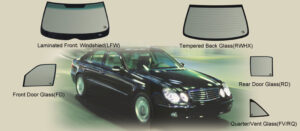 Sometimes, windshield repair is no longer enough and you just have to go for total replacement. If you ever need to have windshield replacement or any other auto glass installation, you will have to choose from three types of car glass. There is dealer glass, original equipment manufactured (OEM) distributor glass and aftermarket glass. Dealer glass is the most expensive type of car glass. This is what you get from the authorized car dealership of your automobile brand. It is expensive because it is made by the exact same manufacturer that produced your vehicle’s original car glass and it usually bears the stamp of your car brand.
Sometimes, windshield repair is no longer enough and you just have to go for total replacement. If you ever need to have windshield replacement or any other auto glass installation, you will have to choose from three types of car glass. There is dealer glass, original equipment manufactured (OEM) distributor glass and aftermarket glass. Dealer glass is the most expensive type of car glass. This is what you get from the authorized car dealership of your automobile brand. It is expensive because it is made by the exact same manufacturer that produced your vehicle’s original car glass and it usually bears the stamp of your car brand.
Those who just need to have everything branded will not go for anything less than dealer glass. Original equipment manufactured distributor car glass means original equipment manufactured car glass. It is identical to dealer glass and has exactly the same specifications, including thickness, color, durability, size and shape. The only difference is that it is made by a different manufacturer. Manufacturers of original equipment manufactured car glass are contracted by the different car brands and are authorized to produce car glass to those exact specifications. Most are well-respected in the industry and their product is recognized as being of equal quality as dealer glass.
Among the top OEM manufacturers are Pilkington, Pittsburg Plate Glass (PPG), Carlite, Ford, Safeguard/Mopar, Asahi, AP Tech, Triplex, Sekurit, Sicursiv, Scanex, Crinamex and Guardian. Keep the list as a handy reference for when you need to check your car glass choices against them. There may be some unscrupulous OEM manufacturers, though.
Be careful of claims that the glass is “from an OEM manufacturer”. Unless the glass itself is described as OEM glass, it may be substandard glass which just happened to be produced by an OEM manufacturer. Aftermarket car glass, also called original equipment equivalent (OEE) car glass, is manufactured by companies who are not legally authorized to make car glass to the exact specifications copyrighted and licensed to car brands. Aftermarket car glass, therefore, has specifications different from your car’s original glass. This may include variations in thickness and quality. Of course, it does not have the same guarantees as dealer glass or original equipment manufactured glass, and may have imperfect fit, leakage, optical distortion, low solar performance and wind noise.
In comparison, therefore, original equipment manufactured car glass is your best choice. It has all the qualities of dealer glass but at a much lower cost. In fact, original equipment manufactured car glass is made according to standards higher than those of the Department of Transportation. Whereas the DOT requires only 80 percent windshield retention in frontal barrier crash tests, original equipment manufactured car glass has 100 percent.
It is imperative that certified auto glass technicians work on your auto glass installation. They should be knowledgeable on the auto glass manufacturer’s specifications and instructions. Aside from making sure that OEM car glass is used for your vehicle, you should also make sure that OEM auto glass parts and adhesives are used. This is for your utmost safety.
With mobile windshield replacement, for example, you are sometimes made to believe that your car is ready to be driven in a while. The problem is that inferior adhesives may not dry in time, leaving you unprotected in case of an accident. Even with the use of an OEM adhesive, you should check the safe drive away time indicated in the product. Furthermore, demand lifetime warranty on auto glass parts and workmanship. Whether for car glass, glass parts or adhesive, or for auto glass installation services, always put safety first.

